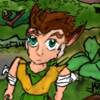HOME | DD
 Dylan613 — New Earth
Dylan613 — New Earth

#speculative #speculativeevolution #customcontinents #fanmadecontinents
Published: 2016-06-03 01:28:20 +0000 UTC; Views: 6657; Favourites: 49; Downloads: 10
Redirect to original
Description
I made earth more interesting place to live in by adding more continents and made some current continents bigger (allowing more biodiversity).1. Hawaii - Due to the new size for this once-small island, it has allowed more diversity in native bird species, as well as preventing many terrestrial bird species (such as Moa-Nalos, etc.) from going extinct. Many native birds like Moa-Nalos, Hawaiian crows, and others have now adapted to deal with introduced species and are now adapting to live in human settlements.
2. (New) New India - This place has real life versions of Net-Navis [similar to many human-like Net-Navis from Megaman Battle Network series] (including Megamen.EXEs, Protomen.EXEs, Bass.EXEs, Searchmen.EXEs, Colonel.EXEs, Tomahawkmen.EXEs, Glyde.EXEs, Serenade.EXEs, Burnermen.EXEs, Plantmen.EXEs, Slashmen.EXEs, Swallowmen.EXEs, Quickmen.EXEs, and Elecmen.EXEs) that fills a niche similar to mainland humans (which originally first evolved in Africa but spread to almost all continents except Antarctica), but ever since people reached this place, people brought all of the native Net-Navis to worldwide, living side-by-side with humans peacefully. They are also 15% smarter than humans, they also use environmental-friendly tech and cultures, unlike humans (which, as of right now, mostly uses tech or cultures that can be harmful to the environment, but Net-Navis are teaching humans technology the Net-Navis made, as well as making humans realizing that human techs are mostly bad for the environment as well as people & Net-Navis), and unlike humans, Net-Navis have mastered Genetic-engineering (whereas humans haven't mastered it yet), time travel, and universe travel (traveling into different fictional universes including How To Train Your Dragon universe, The Croods universe, Pokémon universe, Naruto Universe, Dragonball universe, etc.) [whereas humans never made universe travel]. There are more than 9,185,121,726 Net-Navis on earth alive today, so there are more Net-Navis than humans, making Net-Navi populations the largest population of any species that has ever occurred. Back on New India, this island is also home to, not just Net-Navis, but also modern day dinosaurs (dromaeosaurs, troodonts, oviraptorids, therizinosaurids, ornithomimids, alvarezsaurids, compsognathids, coelophysids, and other small Coelurosaurs), modern day ground sloths, modern day glyptodonts, modern day gastornids (today's gastornids are herbivores like their ancestors, not carnivores as they were incorrectly shown in BBC's walking with prehistoric beasts), modern day pygmy mammoths, modern day pygmy mastodons, modern day pygmy smilodons, New Indian pygmy bison (species of bison that are about the size of a large domestic goat), New Indian common bison, modern day Brontotheres, modern Chalicotheres, Herbivorornids (a group of peaceful and herbivorous descendants of Phorusrhacids), Arsinotheres, Moeritheres (primitive tapir-like elephant relatives), New Indian monkeys (New Indian baboons, New Indian macaques, New Indian langurs, New Indian capuchins, New Indian marmosets, New Indian tamarins, New Indian spider monkeys, etc.), New Indian ape (a chimpanzee-like relative of orangutans that is native to New India, which ranges from the size of a bonobo to the size of a prehistoric Gigantopithecus, making it one of the largest apes on earth, also unlike old world apes, these apes aren't endangered because they adapted to deal with habitat loss, etc. making them the only non-human apes to thrive in newer environments and adapt well with new animals), New Indian lion (descendants of American lion that survived by migrating into New India and stayed in New India ever since), New Indian rhea (giant ostrich-sized rheas that are native to New India), New Indian black bears, New Indian gray wolves, and many other species. This island is mostly covered in rainforests, temperate forests, boreal forests, and grasslands.
3. (New) Isla Nublar/Sorna - This island was founded by humans in 1960's, mainly to introduce the resurrected mesozoic reptile species (including dinosaurs). It is now home to a theme park/safari park known as Jurassic World (formerly Jurassic Park, until the incident in 1993 happened).
Bonus for 3. Land Bridge Between South America And North America - It is now bigger and even more connected than it is in real life, allowing many species of peccaries, guanacos, tapirs of South America, South American monkeys, jaguars, etc. to spread into North America, it has also turned the deserts of California, Nevada, New Mexico, and Arizona into grasslands and forests (with most of northern and central California becoming tropical rainforest due to new geographic changes and slightly warmer weather, other than that), it has saved the few native pleistocene grounds sloth species, as well as some native American tapir species (including California tapirs), native American camel species, glyptodonts, native North American peccaries, Columbian mammoths (although Columbian mammoths aren't as big anymore, they're now between the African elephant's size to the Asian elephant's size), American mastodons, American lions, homotheriums (scimitar-tooth cats), miotoxodons, shrub-oxes, pleistocene pronghorn species, and American cheetahs, from the brink of extinction, and are still alive today.
4.(New) Panem - [I didn't like how North America became Panem in the hunger games series, so I made it a separated place, in an area between Africa and South America] Panem is an island that was infamous for the tournament known as hunger games, which first operated in 1928 and continued for about 70 years, until in 2003, Katnis Everdeen ended the hunger games, so it is now a peaceful place, no longer dystopian. This island is also home to many genetically-engineered species, such as mockingjays, jabberjays, mutt dogs, mutt, monkeys, mutt reptilians, and others, all of each known genetically-engineered species live in human settlements, forests, scrublands, jungles, mountains, wetlands, and grasslands. Some mainland humans have introduced mockingjays and jabberjays into mainland North America and Asia, despite competition with native mainland bluejays and scrubjays, mockingjays and jabberjays still thrive in their new environment.
5. British Isles - Due to larger size, this island now has its own population of European bison, modern day pygmy woolly mammoths, modern day woolly rhinoceroses, modern day megaloceros, etc. Nothing else is changed, other than there is now much less pollution in England and nearby areas.
6. Madagascar - Many species of elephant birds, pygmy elephants, pygmy hippos, large lemurs, giant fossas, etc. are still alive today, due to the landmass is larger than Madagascar in real life. This has also allowed more biodiversity to occur.
7. Tasmania - Due to its larger size, many prehistoric and the (so-called) extinct species, such as diprotodons, thylacines, Zygomaturus, Nototheriums, etc. survived in this island, with some spreading back to Australia after the last Ice Age, and all of the known marsupials and birds from the pleistocene Australia are still alive today in Tasmania, as well as Australia.
8. New Zealand - Moas, Haast's eagles, laughing owls, and many other species survived today, due to the size of the landmass they live on, as well as humans no longer hunting them. Moas are now the most common large bird in New Zealand, with some species adapting to human settlements, including cities. Due to this world's New Zealand being bigger than New Zealand in real life, many modern birds like kakapoos, kiwis, keas, and other species are no longer threatened to extinction, so they now adapted to deal with introduced species and adapted to live in human settlements.
Antarctica - There are now grasslands and forests (not just tundra), so there are now (not just penguins and seals, but also) different kinds of deer species, Antarctican thylacines (wolf-like furry hypercarnivorous thylacines), rhino-like diprotodons (the largest native Antarctican herbivores), native Antarctican geese, native Antarctican passerine birds, etc. living in Antarctica (which lives mostly in forests and grasslands of Antarctica).
10. Land Bridge Between Asia And North America - It is now fully connected, allowing more biodiversity to happen, as well as allowing many old world species, such as Asian elephants, blackbucks, gazelles, buffaloes, tigers, fruit bats (including flying foxes), etc. to spread into North America, thus evolving into native species of North America (example: Flying foxes in North America are known as North American flying foxes), whereas also allowing the spread of new world North American animals including cougars, bison, mule deer, whitetail deer, etc. into Asia (example: cougars that spread into Asia evolved into Asian cougars).
11. Red/Black Sea - Unfortunately for the black sea and the red sea, they both dried out, being eventually replaced by forests and grasslands, allowing more biodiversity in Asia and Europe, with some European animals including European bison, white storks, etc. spreading to Asia, while some Asian animals, such as wild water buffaloes, leopards, blackbucks, etc. spreading to Europe, thus evolving into native species of each continents.
12. Mediterranean Islands - These islands are now bigger, allowing more biodiversity, as well as saving its native dwarf elephants, giant dormice, etc. from extinction. Nothing else is changed, other than there are no domestic livestock (although native people of these islands farm dwarf elephants and giant dormice, instead of cows, pigs, sheep, or goats) and there's a lot less pollution.
13. Land Bridge Between Africa And Asia - It is now much bigger and less dry, allowing more biodiversity, and allowing many African species to spread into Asia, as well as allowing Asian species to spread into Africa.
14. (New) Land Bridge Between Africa And Europe - There is now a land bridge between Africa and Spain, allowing more biodiversity, as well as allowing many European species to spread into Africa, as well as allowing African species to spread into Europe. Since the Mediterranean sea is now isolated from the rest of the Atlantic ocean, the Mediterranean sea now has life that are found nowhere else on the planet, such as Snakeneck sea lions (a family of sea lions with long Cryptoclidus-like necks, filling the plesiosaur's niche), Swordnose dolphins (a group of dolphins with swordfish-like snouts), Night dolphins (a group of nocturnal dolphins with large eyes to see well in the dark of both ocean's depths and in night, filling the ophthalmosaurus's niche), Megaporpoises (a group of giant sized porpoises that are predatory and fills the niche similar to orcas, mako sharks, crocodiles, great white sharks, etc.), Hammerhead whales (a group of toothed whales that are closely related to belugas, but are dark gray [rather than white] and has hammer-shaped extensions with an eye at the end of each extensions, much like hammerhead sharks), etc.
Related content
Comments: 7

👍: 0 ⏩: 0

it's no problem ^^
be sure to comment on the pick I left you a link to too ^^ I'd like to here your thoughts on it ^^.
I'm routing for you.
👍: 0 ⏩: 0

Thisd is a Pretty cool map and I like your style, but I feel all the deeper connected of land mass and lack of seas and desserts might not help every life form as these are still important to other creatures and animals as well.
Still I think I might be able to share concept with you, that you might like and could Aply to with your own ideas if your Enterested that is?
reaverpan.deviantart.com/art/E… alook at the link
Anyways love the map offer alot of ideas for differant Scenarios and love how your trying to prevet extictions and make things more possable to find more life ^^.
👍: 0 ⏩: 1

Thanks! This is my first time in making maps on deviantart. 😅
👍: 0 ⏩: 0





















